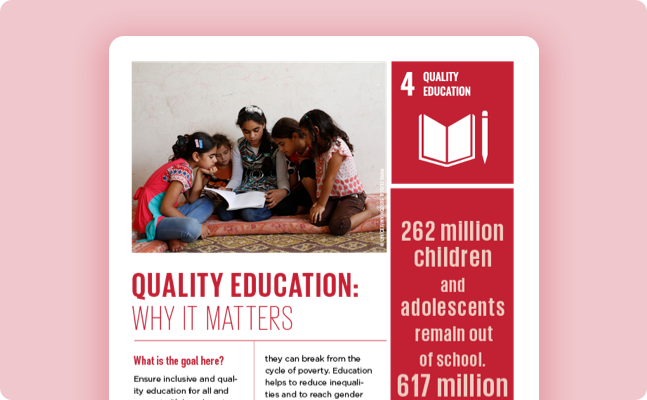6 Education For All Goals
This level of optimism, along with the June 6 statement of incoming Education Secretary Leonor Briones espousing “Education for All” as a major Millennium Development Goal, is most reassuring of the high priority that education will continue to be given. The 2030 Agenda for Sustainable Development, adopted by all United Nations Member States in 2015, provides a shared blueprint for peace and prosperity for people and the planet, now and into the future.At its heart are the 17 Sustainable Development Goals (SDGs), which are an urgent call for action by all countries - developed and developing - in a global partnership. All SDGs Goal 4-Quality Education Goal 1 – No Poverty Goal 3- Good Health and Well-Being Goal 5- Gender Equality Goal 6-Clean Water and Sanitation Goal 8- Decent Work and Economic Growth Goal 10–Reduced Inequalities Goal 11- Sustainable Cities and Communities Goal 16 – Peace, Justice and Strong Institutions. Inclusive learning provides all students with access to flexible learning choices and effective paths for achieving educational goals in spaces where they experience a sense of belonging. In an inclusive education environment, all children, regardless of ability or disability, learn together in the same age-appropriate classroom. S ustainable development goals to be agreed by world leaders this week include a commitment to ensure that all young people have access to good quality primary and lower secondary education.
. I realised that a post on what these goals are and their origins was in order, so the following provides a background of the EFA goals and MDGs.What Are Some Education Goal
Education for All Goals:
The Education for All movement is a global commitment to provide quality basic education for all children, youth and adults. The movement was launched at the World Conference on Education for All in 1990 by UNESCO, UNDP, UNFPA, UNICEF and the World Bank. Participants endorsed an ‘expanded vision of learning’ and pledged to universalize primary education and massively reduce illiteracy by the end of the decade. UNESCO is the lead agency, and as such, has been mandated to coordinate the international efforts to reach Education for All.
Ten years later, with many countries far from having reached this goal, the international community met again at the World Education Forum held in Dakar, Senegal, in April 2000. 164 countries agreed on six EFA goals to be achieved by 2015, which would dramatically improve learning opportunities for children, youth, and adults.
Goal 1: Expanding and improving comprehensive early childhood care and education, especially for the most vulnerable and disadvantaged children.
Goal 2: Ensuring that by 2015 all children, particularly girls, children in difficult circumstances and those belonging to ethnic minorities, have access to, and complete, free and compulsory primary education of good quality.
Goal 3: Ensuring that the learning needs of all young people and adults are met through equitable access to appropriate learning and life-skills programmes.
Goal 4: Achieving a 50 per cent improvement in levels of adult literacy by 2015, especially for women, and equitable access to basic and continuing education for all adults.
Goal 5: Eliminating gender disparities in primary and secondary education by 2005, and achieving gender equality in education by 2015, with a focus on ensuring girls’ full and equal access to and achievement in basic education of good quality.
Goal 6: Improving all aspects of the quality of education and ensuring excellence of all so that recognized and measurable learning outcomes are achieved by all, especially in literacy, numeracy and essential life skills.
Key documents and websites:
Millennium Development Goals
In September 2000, building upon a decade of major United Nations conferences and summits, world leaders came together at United Nations Headquarters in New York to adopt the United Nations Millennium Declaration, committing their nations to a new global partnership to reduce extreme poverty and setting out a series of time-bound targets – with a deadline of 2015 – that have become known as the Millennium Development Goals.
There are eight goals with 21 targets, and a series of measurable indicators for each target.
Goal 1: Eradicate extreme poverty and hunger
Goal 2: Achieve universal primary education
Goal 3: Promote gender equality and empower women
Goal 4: Reduce child mortality rates
Goal 5: Improve maternal health
Goal 6: Combat HIV/AIDS, malaria, and other diseases
Goal 7: Ensure environmental sustainability
Goal 8: Develop a global partnership for development
The Millennium Development Goals (MDGs) are the most broadly supported, comprehensive and specific development goals the world has ever agreed upon. These eight time-bound goals provide concrete, numerical benchmarks for tackling extreme poverty in its many dimensions. They include goals and targets on income poverty, hunger, maternal and child mortality, disease, inadequate shelter, gender inequality, environmental degradation and the Global Partnership for Development.
The MDGs are both global and local, tailored by each country to suit specific development needs. They provide a framework for the entire international community to work together towards a common end – making sure that human development reaches everyone, everywhere. If these goals are achieved, world poverty will be cut by half, tens of millions of lives will be saved, and billions more people will have the opportunity to benefit from the global economy.



6 Goals Of Education For All

Key documents and websites:
Physical Education Goals For Teachers
In conclusion, the EFA goals contribute to the global pursuit of the eight Millennium Development Goals (MDGs). Two MDGs relate specifically to education but none of the eight MDGs can be achieved without sustained investment in education. Education gives the skills and knowledge to improve health, livelihoods and promote sound environmental practices.